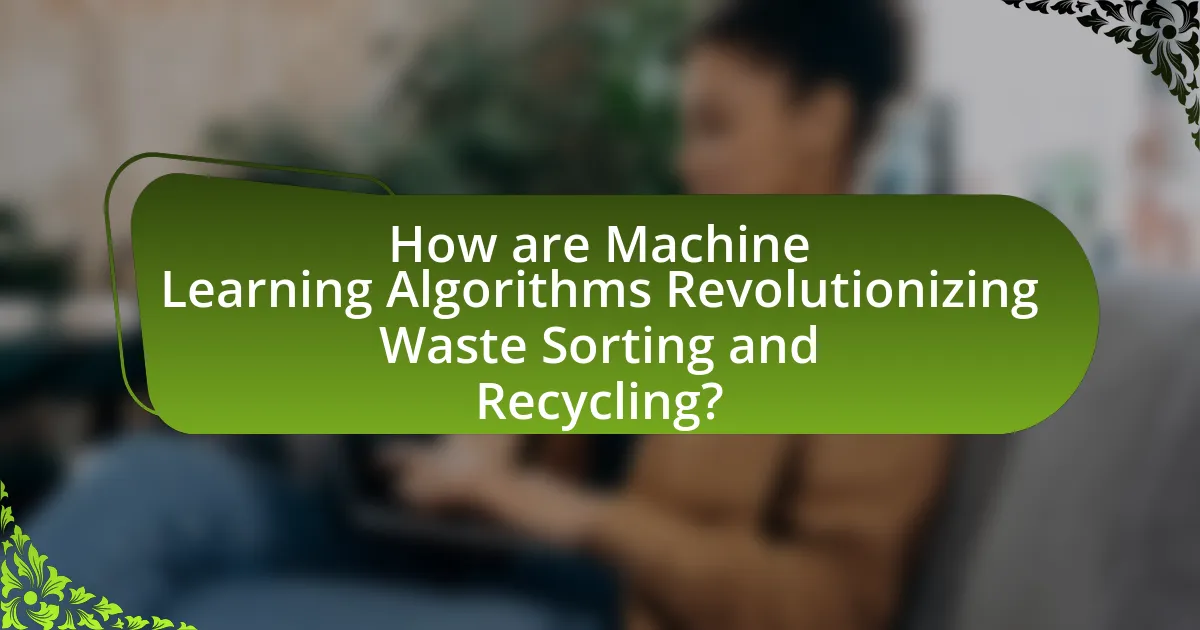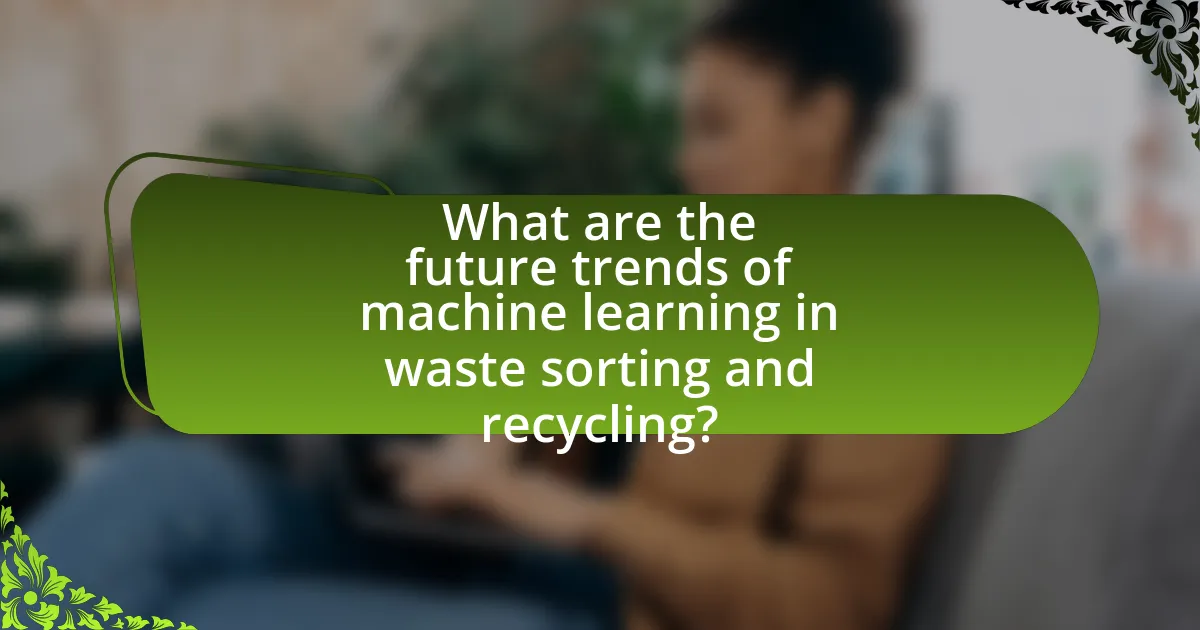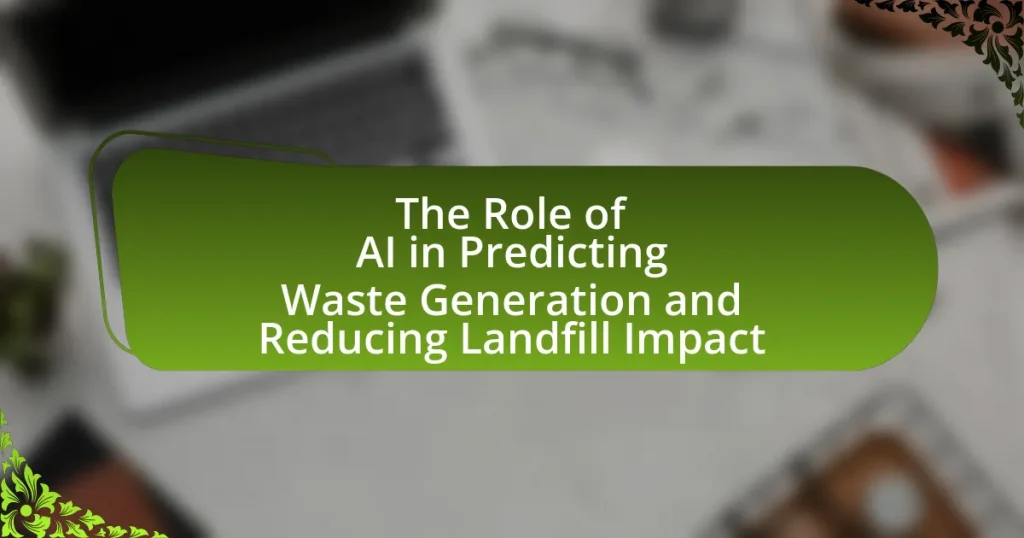Machine learning algorithms are significantly transforming waste sorting and recycling by improving the accuracy and efficiency of material identification and classification. Utilizing advanced techniques such as computer vision and deep learning, these algorithms can achieve over 90% accuracy in distinguishing between various waste materials, leading to enhanced recycling rates and reduced contamination. The integration of machine learning with technologies like robotics and sensor systems further optimizes waste management processes, addressing challenges such as misclassification and operational inefficiencies. This article explores the role of machine learning in modern recycling systems, the types of data analyzed, the benefits of improved sorting accuracy, and future trends in waste management.

How are Machine Learning Algorithms Revolutionizing Waste Sorting and Recycling?
Machine learning algorithms are revolutionizing waste sorting and recycling by enhancing the accuracy and efficiency of material identification and classification. These algorithms utilize computer vision and deep learning techniques to analyze images of waste, enabling automated systems to distinguish between different types of materials, such as plastics, metals, and organics, with high precision. For instance, a study by the Massachusetts Institute of Technology demonstrated that machine learning models could achieve over 90% accuracy in identifying recyclable materials, significantly improving sorting processes compared to traditional methods. This advancement not only increases recycling rates but also reduces contamination in recycling streams, leading to more effective resource recovery and lower operational costs for recycling facilities.
What role do machine learning algorithms play in waste management?
Machine learning algorithms play a crucial role in waste management by enhancing the efficiency and accuracy of waste sorting and recycling processes. These algorithms analyze large datasets to identify patterns and classify waste materials, enabling automated systems to sort recyclables from non-recyclables with high precision. For instance, a study published in the journal “Waste Management” demonstrated that machine learning models could achieve over 90% accuracy in identifying different types of waste, significantly improving recycling rates and reducing contamination. By optimizing collection routes and predicting waste generation trends, machine learning also aids in resource allocation and operational efficiency within waste management systems.
How do these algorithms improve the accuracy of waste sorting?
Machine learning algorithms improve the accuracy of waste sorting by utilizing advanced image recognition and classification techniques to identify and categorize waste materials. These algorithms analyze visual data from cameras and sensors, achieving high precision in distinguishing between different types of waste, such as plastics, metals, and organics. For instance, studies have shown that machine learning models can achieve over 90% accuracy in waste classification, significantly reducing contamination rates in recycling streams. This enhanced accuracy leads to more efficient recycling processes and better resource recovery, ultimately contributing to more sustainable waste management practices.
What types of data do machine learning algorithms analyze in recycling processes?
Machine learning algorithms analyze various types of data in recycling processes, including image data, sensor data, and operational data. Image data is utilized for identifying and classifying materials through computer vision techniques, enabling accurate sorting of recyclables. Sensor data, such as weight, volume, and material composition, helps in assessing the quality and type of waste being processed. Operational data, including processing times and efficiency metrics, allows for optimization of recycling workflows. These data types collectively enhance the effectiveness and efficiency of recycling operations, as evidenced by studies showing improved sorting accuracy and reduced contamination rates in recycling facilities.
Why is machine learning essential for modern recycling systems?
Machine learning is essential for modern recycling systems because it enhances the efficiency and accuracy of waste sorting processes. By utilizing algorithms that can analyze vast amounts of data, machine learning systems can identify and categorize different types of materials with high precision. For instance, a study by the Massachusetts Institute of Technology demonstrated that machine learning models could achieve over 90% accuracy in identifying recyclable materials compared to traditional methods, which often fall below 70%. This increased accuracy not only improves recycling rates but also reduces contamination in recycling streams, leading to higher quality recycled materials and more sustainable waste management practices.
How does machine learning enhance operational efficiency in recycling facilities?
Machine learning enhances operational efficiency in recycling facilities by optimizing sorting processes and improving material recovery rates. By utilizing algorithms that analyze data from various sources, recycling facilities can automate the identification and classification of recyclable materials, significantly reducing manual labor and increasing throughput. For instance, a study by the National Recycling Coalition found that implementing machine learning in sorting systems can improve accuracy by up to 90%, leading to higher quality outputs and reduced contamination rates. This efficiency not only lowers operational costs but also maximizes the amount of material diverted from landfills, contributing to more sustainable recycling practices.
What challenges in waste sorting does machine learning address?
Machine learning addresses several challenges in waste sorting, including the accurate identification of materials, the reduction of contamination rates, and the optimization of sorting processes. Traditional waste sorting methods often struggle with misclassification of materials, leading to increased contamination and inefficiencies. Machine learning algorithms, particularly those utilizing computer vision, can analyze images of waste items to classify them with high accuracy, achieving classification rates above 90% in some studies. Additionally, machine learning can adapt to new materials and changing waste streams, improving the overall efficiency of recycling operations by automating sorting tasks and reducing labor costs.
What are the key benefits of using machine learning in waste sorting?
The key benefits of using machine learning in waste sorting include increased accuracy, efficiency, and cost-effectiveness. Machine learning algorithms can analyze vast amounts of data to identify and classify different types of waste materials with high precision, reducing contamination rates in recycling streams. For instance, a study by the Massachusetts Institute of Technology demonstrated that machine learning models could achieve over 90% accuracy in identifying recyclable materials compared to traditional methods. Additionally, these algorithms can optimize sorting processes, leading to faster processing times and lower operational costs, as evidenced by implementations in facilities that reported up to 30% reductions in labor costs.
How does machine learning contribute to reducing contamination in recyclables?
Machine learning contributes to reducing contamination in recyclables by enhancing the accuracy of sorting processes. Advanced algorithms analyze visual data from recycling streams, identifying materials and contaminants with high precision. For instance, a study by the Massachusetts Institute of Technology demonstrated that machine learning models could achieve over 90% accuracy in classifying recyclable materials, significantly minimizing the presence of non-recyclables in sorted streams. This improved sorting capability leads to cleaner recyclables, ultimately increasing the efficiency of recycling operations and reducing contamination rates.
What impact does machine learning have on recycling rates and sustainability?
Machine learning significantly enhances recycling rates and sustainability by optimizing waste sorting processes. Algorithms can analyze and classify materials more accurately than traditional methods, leading to higher recovery rates of recyclable materials. For instance, a study by the Massachusetts Institute of Technology found that machine learning models improved sorting accuracy by over 90%, which directly correlates with increased recycling efficiency. This technological advancement not only reduces contamination in recycling streams but also minimizes landfill waste, thereby promoting environmental sustainability.

What technologies are integrated with machine learning for waste sorting?
Technologies integrated with machine learning for waste sorting include computer vision, robotics, and sensor technologies. Computer vision algorithms analyze images of waste to identify and classify materials, enabling automated sorting processes. Robotics systems equipped with machine learning capabilities can physically separate waste based on the classifications made by computer vision. Additionally, sensor technologies, such as infrared and near-infrared spectroscopy, provide real-time data on material composition, enhancing the accuracy of sorting decisions. These technologies collectively improve efficiency and effectiveness in waste management systems.
How do computer vision systems work alongside machine learning in recycling?
Computer vision systems work alongside machine learning in recycling by enabling automated identification and classification of recyclable materials. These systems utilize algorithms trained on large datasets of images to recognize different types of waste, such as plastics, metals, and paper. For instance, a study by the Massachusetts Institute of Technology demonstrated that machine learning models could achieve over 90% accuracy in identifying recyclable items through image recognition techniques. This integration enhances sorting efficiency, reduces contamination rates, and ultimately improves recycling rates by ensuring that materials are correctly processed.
What are the advantages of using computer vision for waste identification?
The advantages of using computer vision for waste identification include increased accuracy, efficiency, and the ability to automate sorting processes. Computer vision systems can analyze images of waste materials with high precision, identifying different types of recyclables and contaminants effectively. For instance, studies have shown that computer vision can achieve over 90% accuracy in identifying recyclable materials, significantly reducing human error in sorting. Additionally, these systems can operate continuously and at high speeds, enhancing the throughput of recycling facilities. This automation not only speeds up the sorting process but also lowers operational costs and improves overall recycling rates, contributing to more sustainable waste management practices.
How does sensor technology complement machine learning in waste management?
Sensor technology enhances machine learning in waste management by providing real-time data on waste composition and volume. This data allows machine learning algorithms to analyze patterns, optimize sorting processes, and improve recycling efficiency. For instance, sensors can detect the type of materials in waste bins, enabling algorithms to classify and sort waste more accurately. Studies show that integrating sensor data with machine learning can increase recycling rates by up to 30%, demonstrating the effectiveness of this technological synergy in optimizing waste management systems.
What role does data collection play in enhancing machine learning algorithms?
Data collection is crucial for enhancing machine learning algorithms as it provides the necessary input data that these algorithms learn from. High-quality, diverse datasets enable algorithms to identify patterns and make accurate predictions, which is essential in applications like waste sorting and recycling. For instance, a study by Google AI demonstrated that using large datasets significantly improved the accuracy of image classification models, achieving up to 95% accuracy in identifying objects. This illustrates that comprehensive data collection directly correlates with the performance and reliability of machine learning systems.
How is data quality ensured for effective machine learning applications?
Data quality for effective machine learning applications is ensured through rigorous data validation, cleaning, and preprocessing techniques. These processes involve identifying and correcting inaccuracies, removing duplicates, and standardizing data formats to enhance consistency. For instance, a study by Kelleher and Tierney (2018) highlights that implementing data cleaning methods can improve model performance by up to 30%. Additionally, continuous monitoring and updating of datasets are crucial to maintain relevance and accuracy, as outdated or biased data can lead to flawed predictions.
What types of data are most valuable for training machine learning models in recycling?
The most valuable types of data for training machine learning models in recycling include image data, sensor data, and material composition data. Image data, such as photographs of recyclable materials, enables models to recognize and classify items effectively, as demonstrated by studies showing that convolutional neural networks can achieve over 90% accuracy in identifying recyclables. Sensor data, including weight, volume, and material type from smart bins, provides real-time insights into waste characteristics, enhancing sorting efficiency. Additionally, material composition data, which details the chemical and physical properties of recyclables, supports models in predicting recycling outcomes and optimizing processes. These data types collectively enhance the performance and accuracy of machine learning applications in recycling.

What are the future trends of machine learning in waste sorting and recycling?
Future trends of machine learning in waste sorting and recycling include enhanced automation, improved accuracy in material identification, and the integration of real-time data analytics. Automation will streamline sorting processes, reducing labor costs and increasing efficiency. Machine learning algorithms will utilize advanced image recognition techniques to accurately classify materials, achieving over 90% accuracy in some cases, as demonstrated by systems like AMP Robotics. Additionally, real-time data analytics will enable dynamic adjustments in sorting operations based on incoming waste streams, optimizing recycling rates and reducing contamination. These trends indicate a significant shift towards smarter, more efficient waste management systems.
How is artificial intelligence expected to evolve in waste management?
Artificial intelligence is expected to evolve in waste management by enhancing sorting accuracy, optimizing collection routes, and improving recycling processes. Machine learning algorithms will increasingly analyze waste composition data to identify materials more effectively, leading to higher recycling rates. For instance, AI-driven systems can utilize computer vision to distinguish between different types of plastics and metals, which can significantly reduce contamination in recycling streams. Additionally, predictive analytics will enable waste management companies to optimize collection schedules based on real-time data, reducing operational costs and environmental impact. This evolution is supported by advancements in sensor technology and data analytics, which are becoming more integrated into waste management systems.
What innovations are on the horizon for machine learning in recycling?
Innovations on the horizon for machine learning in recycling include advanced image recognition systems, predictive analytics for waste generation, and automated sorting technologies. These innovations aim to enhance the efficiency and accuracy of recycling processes. For instance, machine learning algorithms can analyze images of waste materials to identify and categorize them with high precision, significantly improving sorting accuracy. Additionally, predictive analytics can forecast waste trends, allowing recycling facilities to optimize operations and resource allocation. Automated sorting technologies, powered by machine learning, can streamline the separation of recyclables from non-recyclables, reducing contamination rates and increasing recycling rates.
How might regulations influence the adoption of machine learning in waste sorting?
Regulations can significantly influence the adoption of machine learning in waste sorting by establishing standards that encourage technological integration. For instance, stringent recycling mandates can drive municipalities and companies to implement machine learning systems to enhance sorting accuracy and efficiency. Evidence from the European Union’s Circular Economy Action Plan shows that regulatory frameworks promoting recycling targets have led to increased investment in automated sorting technologies, including machine learning algorithms, which improve material recovery rates by up to 30%. Thus, regulations not only create a demand for advanced sorting solutions but also provide a framework that supports innovation in waste management practices.
What best practices should be followed when implementing machine learning in recycling?
Best practices for implementing machine learning in recycling include ensuring high-quality data collection, selecting appropriate algorithms, and continuous model evaluation. High-quality data is crucial as it directly impacts the accuracy of machine learning models; for instance, using diverse datasets that represent various waste types can enhance model performance. Selecting algorithms that are well-suited for the specific recycling tasks, such as image recognition for sorting materials, is essential for effective implementation. Continuous evaluation and updating of models based on new data and changing waste patterns ensure that the system remains efficient and accurate over time. These practices are supported by case studies demonstrating improved sorting accuracy and operational efficiency in recycling facilities that have adopted machine learning technologies.
How can organizations ensure successful integration of machine learning technologies?
Organizations can ensure successful integration of machine learning technologies by establishing a clear strategy that aligns with their business objectives. This involves identifying specific use cases where machine learning can add value, such as optimizing waste sorting processes or improving recycling rates. Additionally, organizations should invest in the necessary infrastructure, including data collection and storage systems, to support machine learning initiatives.
Moreover, fostering a culture of collaboration between data scientists and domain experts is crucial, as it enhances the understanding of both technical and operational aspects. Training staff on machine learning tools and methodologies further facilitates adoption. According to a McKinsey report, companies that effectively integrate advanced analytics into their operations can achieve productivity gains of 20-25%. This statistic underscores the importance of a structured approach to machine learning integration.
What common pitfalls should be avoided in machine learning waste sorting projects?
Common pitfalls to avoid in machine learning waste sorting projects include inadequate data quality, insufficient training data, and lack of domain expertise. Inadequate data quality can lead to poor model performance, as models trained on noisy or biased data may misclassify waste types. Insufficient training data can result in overfitting, where the model learns to recognize only the specific examples it was trained on, failing to generalize to new data. Additionally, lack of domain expertise can hinder the development of effective algorithms, as understanding the nuances of waste materials is crucial for accurate sorting. These pitfalls are supported by studies indicating that high-quality, diverse datasets significantly improve machine learning outcomes in waste management applications.



